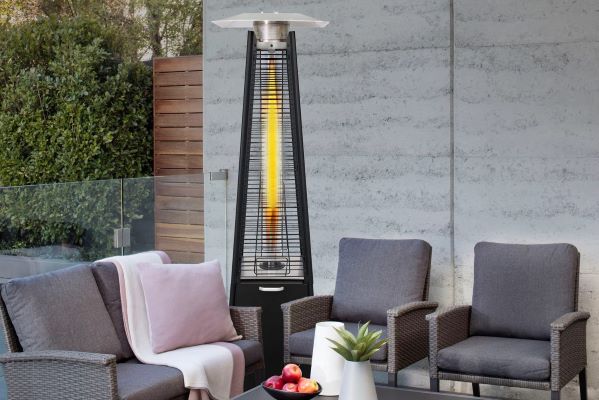
Outdoor Heaters: Outdoor Gas Heaters – Gas Patio Heater Guide
An outdoor gas heater (outdoor mushroom heater) provide portable gas radiant heating for outdoor heater use. Outdoor gas heaters come in both LPG (propane) and natural gas outdoor heater types.
A gas outdoor heater uses a gas burner to heat a ceramic or metal heating element via gas combustion.
The gas outdoor heater element uses the familiar umbrella reflectors, as seen in an outdoor mushroom heater, to radiate the heat.
An gas outdoor heater uses radiant heat as opposed to fan driven convection heating.
The radiant (infrared) energy warms people and objects within a direct line of sight of the outdoor heater, just like the sun.
Being devoid of a fan makes an gas patio heater very quiet, adding to the pleasant atmosphere created.
Gas Outdoor Heater Types
Gas outdoor heaters come in a variety of configurations including the ubiquitous outdoor mushroom heater style of gas patio heater as well as some more exotic types.
Outdoor Mushroom Heater
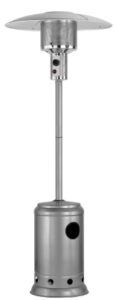 The outdoor mushroom heater is the most common type of gas outdoor heater, seen in backyards around the country.
The outdoor mushroom heater is the most common type of gas outdoor heater, seen in backyards around the country.
Typically about 2 metres in height, this type of gas outdoor heater has good line of sight to all areas surrounding it, providing warmth to the entire area.
An outdoor mushroom heater has a simple design, with the radiant heat generated by the gas burner driven heating element bouncing off the namesake mushroom reflector.
The fuel source is a gas bottle in the base which also acts as ballast to prevent the outdoor heater from blowing over in a stiff breeze.
However, the outdoor mushroom heater stills come equipped with tip over shut off switches, should the wind or a party guest knock it over, as well as a flame sensor shutoff.
Ignition is provided by a piezo electric button, the outdoor heater is adjustable, and wheels provide ease of movement.
The simple design makes an outdoor mushroom heater the least expensive outdoor heater type, accounting for their popularity.
Pyramid Flame Heater: Quartz or Glass Tube Gas Outdoor Heaters
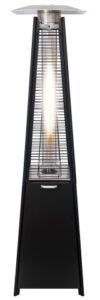 Pyramid flame heaters are easily the most visually attractive gas outdoor heater, and the flame is intriguing to watch, almost hypnotic.
Pyramid flame heaters are easily the most visually attractive gas outdoor heater, and the flame is intriguing to watch, almost hypnotic.
The radiant heat and flame are adjustable, and the ignition is by piezo electric button.
Pyramid patio heaters are relatively new, having only been around for about 15 years, compared to decades for the outdoor mushroom heater.
As with the outdoor mushroom heater, the gas bottle is located in the base and is usually equipped with wheels.
Combined with a wider base and less ‘sail’ area, pyramid outdoor heaters are a bit more stable in the wind, although they still come with safety tip over switches.
Other safety features may include an oxygen depletion sensor to switch off the heater when the ambient oxygen level drops and a flame sensor that shuts off the gas if the flame goes out.
These gas outdoor heaters typically come equipped with wheels for portability.
Area Outdoor Gas Heater
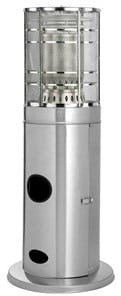 An area gas outdoor heater is the shorter sibling of outdoor gas heaters.
An area gas outdoor heater is the shorter sibling of outdoor gas heaters.
These are also radiant heaters with a gas heating element/burner surrounded by a 360° metal mesh enclosure and with piezo electric ignition.
The shorter stature of this outdoor heater is advantageous with lower overhead clearance, as with patio covers and screen rooms.
The lower centre of gravity also makes them less likely to get knocked over, although they still have safety tip over switches.
The disadvantage is the diminished line of sight and radiant coverage.
Additional outdoor heater safety features may include an oxygen depletion sensor to switch off the outdoor heater when the ambient oxygen level drops and a flame sensor that shuts off the gas if the flame goes out.
Gas Fire Pit Outdoor Heater
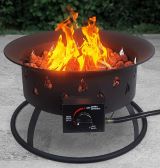 A gas fire pit is the one type of outdoor heater that can be either portable or inbuilt, making these gas outdoor heaters more natural gas friendly.
A gas fire pit is the one type of outdoor heater that can be either portable or inbuilt, making these gas outdoor heaters more natural gas friendly.
Gas fire pits usually have a round or rectangular bowl with the gas burner at the bottom and glass beads, lava rocks or stones over the top, to hide the burner.
The flame media may similarly be simulated logs, and the gas fire pit may also include a low glass barrier around the perimeter.
A gas fire pit outdoor heater is the classic ‘conversation piece’ usually surrounded by seating… get out the marshmallows!
The disadvantage is that the radiant heat is limited to a smaller area.
Whilst there are smaller portable gas fire pit versions fueled by LPG gas bottles (see image), most are permanently built and use either natural gas or plumbed LPG.
Permanently built outdoor heaters are more expensive than the aforementioned outdoor gas heaters.
Outdoor Gas Heater Fireplace
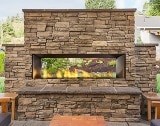 The largest, most impressive and priciest outdoor gas heater is an outdoor gas heater fireplace.
The largest, most impressive and priciest outdoor gas heater is an outdoor gas heater fireplace.
These are very similar to an indoor gas fireplace except they are designed for 360° viewing and intended to withstand the elements.
You can typically choose your flame media from simulated logs, various coloured stones, lava rocks or pebbles.
Glass surrounds, Wi-Fi enabled, and traditional remote controls are the norm.
The gas supply is plumbed in and can be either natural gas or LPG.
In addition to the high unit cost, be prepared for a substantial installation and gas fitter expense, as well.
Gas Chiminea Outdoor Heater
While the vast majority of chimineas are fueled by wood or charcoal, there are now some gas chimineas on the market.
Unlike traditional ceramic chimineas, gas chimenea outdoor heaters are typically steel with a black paint finish, as a stainless-steel finish would spoil the look.
As with other portable outdoor gas heaters, the gas bottle goes in the base.
Table Top Gas Outdoor Heater
The table top gas outdoor heater is the even shorter sibling of gas outdoor heaters.
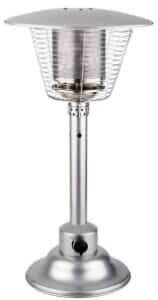 These diminutive gas outdoor heaters are, as described, intended for tabletop use.
These diminutive gas outdoor heaters are, as described, intended for tabletop use.
While most are like a short outdoor mushroom heater, there are also little pyramids with pyramid gas table top heaters.
Unlike their full-size brethren, the table top gas outdoor heater gets its fuel from a gas hose, in lieu of a gas bottle housed within.
No wheels required but the typical safety features are included.
Natural Gas Outdoor Heater
The natural gas outdoor heater is not nearly as common as the LPG outdoor gas heaters.
The reasons are simple: lack of portability and the cost of installation.
In addition, not all models are available in a natural gas outdoor heater version.
Fuel Choices for an Outdoor Gas Heater
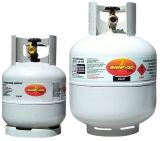 A portable outdoor gas heater is fueled by LPG (propane) from a gas bottle.
A portable outdoor gas heater is fueled by LPG (propane) from a gas bottle.
Most use a 9kg gas bottle but some will also accept the larger 13.5kg gas bottles.
An inbuilt gas fire pit or outdoor gas heater fireplace can use either natural gas or LPG, both permanently plumbed in.
Finishes for Outdoor Gas Heaters
As virtually all outdoor gas heaters are made of steel, the most popular finish is stainless steel, as it doesn’t rust and requires little maintenance.
The other choice is that of a durable powder coated paint finish which, like the Model T, is only available in black.
- Elgas to the Rescue with Helicopter LPG Delivery - November 14, 2024
- Outdoor Heaters: Outdoor Gas Heaters – Gas Patio Heater Guide - September 22, 2024
- LPG Meaning – LPG Means: What Does LPG Stand For - August 31, 2024
Steve Reynolds
Technical Consultant
Steve Reynolds is a leading expert in the LPG industry with over 22 years of experience. As part of the national management team at ELGAS, Steve ensures the safe and efficient storage, handling, and transportation of LPG. He serves as the lead investigator for incidents and collaborates with authorities on industry developments.
Steve is a technical advisor to Standards Australia and Gas Energy Australia (GEA), and an active member of the World LPG Association (WLPGA), contributing to global standards and technical reviews. He holds a BSc. (Hons) in Industrial Chemistry from UNSW and has held senior safety and technical roles at ELGAS, making him a trusted authority in LPG safety and standards.
